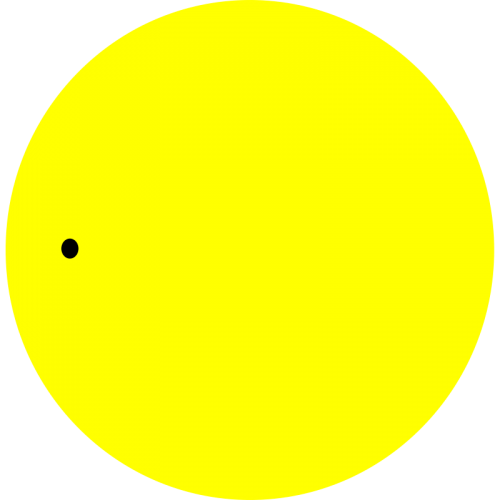Observers around the World are getting ready to watch the transit of Mercury this coming Monday, November 11, 2019. Transits are rare events, one can expect to see fewer than 10 of them in their lifetime, so the upcoming Mercury passage is not to be missed. Here are all the whats, whys and hows of this exciting cosmic spectacle.
What’s a transit?
Transit is the passage of Mercury in front of the face of the Sun. From the Earth only the two innermost planets, Mercury and Venus, can be seen transiting in front of our star. Transit of Mercury occurs only 13 or 14 times a century and transit of Venus even less often. But why so seldom? Mercury orbits the Sun once every 88 Earth days. So one would expect to see at least three transits of Mercury every year, right? It turns out that Mercury’s orbit is tilted. Therefore most of the times the little planet passes just above or just below the solar disc as seen from Earth. The alignment is only possible on those rare occasions when the orbital planes of the Earth and Mercury cross. When that happens, we see the tiny Mercury transit, or pass, in front of the Sun.
How can I watch the transit of Mercury?
Because Mercury is so small, the transit can only be observed with a binocular or a telescope. If you are planning to watch the event, remember: you should NEVER EVER look at the Sun directly through an optical instrument as doing so can damage your eyes. Just like when you observe a solar eclipse, special solar filter must be fitted on your scope/ binocular to safely observe the passage of Mercury. Alternatively, you can place a white screen behind the telescope’s eyepiece and look at the image of the Sun on the screen (if using a binocular, cover one of the lenses)! You can also watch the event LIVE online via The Virtual Telescope.
Where can I see the event from?
The 2019 transit will be visible from many places around the Globe. But whether you will be able to see the whole event, a part of it or none at all depends on where you live (see the map of the transit for more details). The whole transit, from the first contact (when Mercury first touches the Sun) to the fourth contact (when Mercury last touches the Sun) will take about 5 hours and 25 minutes. In the UK the first contact will occur at 12:35 PM GMT. The maximum transit will happen at 3:19 PM GMT and the Sun will set at 4:18 PM GMT, almost two hours before the end of the transit.
Transit of Mercury as an educational opportunity
The upcoming transit is not only your chance to witness the rare cosmic event and to brush up on your knowledge of celestial mechanics but also an opportunity to calculate the value of the Astronomical Unit (AU). Just to remind you: Astronomical Unit is the mean Earth-Sun distance.
An English 18th century astronomer Edmund Halley first came up with a way to measure the distance to our star using the transit of Venus. But the same method can be applied to the passage of Mercury. To calculate the AU, two observers must watch the event from two different locations on Earth and then compare the data. Many amateur astronomers, astronomy students and secondary school pupils will be making the measurements on November 11th. We hope you will be one of them!
For more information about Halley’s method and upcoming Mercury observations check out
- Halley’s original 1716 paper (translated into English :))
- Article about Citizen ToM (Transit of Mercury) project by Zack Stockbridge, the project coordinator
- If you are looking for an observational partner, see the Mercury observers list
Good luck, clear skies and safe Sungazing!
Any questions or comments? Visit our portable star dome website, come to our space shows or contact our mobile planetarium team.

